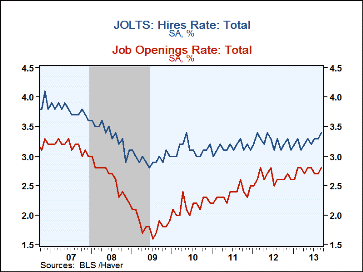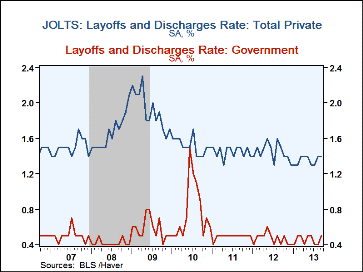 Global| Nov 22 2013
Global| Nov 22 2013U.S. JOLTS: Job Openings & Hires Rates Move Up
by:Tom Moeller
|in:Economy in Brief
Summary
The Bureau of Labor Statistics reported in its Job Openings & Labor Turnover Survey (JOLTS) that the September job openings rate rose to 2.8% from a downwardly-revised 2.7% in August. The job openings rate is the number of job [...]
The Bureau of Labor Statistics reported in its Job Openings & Labor Turnover Survey (JOLTS) that the September job openings rate rose to 2.8% from a downwardly-revised 2.7% in August. The job openings rate is the number of job openings on the last business day of the month as a percent of total employment plus job openings. The actual number of job openings rose 8.6% y/y to 3.913 million.
The private-sector job openings rate increased to 3.0% from 2.9% in August. The rate in education & health services held at a cycle-high of 3.4%. Also, the rate in professional & business services rose to 3.5% but remained down from the 4.2% high early last year. The rate in manufacturing slipped to 2.1%. In the government sector, the job openings rate held at 1.7%, its lowest level since December.
The hires rate improved to 3.4% from 3.3% in August, equaling the expansion's high. The hires rate is the number of hires during the month divided by employment. The hires rate in the private sector rose to 3.8%. The hires rate of 5.4% in leisure & hospitality remained down from its March '12 high of 5.9%. Also, the relatively high 5.1% in construction was well below the 6.5% rates common early in 2011. The hiring rate of 4.1% in retail trade was down from August while the hiring rate in education & health services dropped sharply to 2.5%. In the factory sector, the rate was stable m/m at 2.1%, improved from 1.7% six months ago. The government sector hires rate slipped to 1.3%.
The number of hires rose 0.6% m/m in September and were 8.7% above last year. Private sector hires advanced 9.1% y/y. Hiring in professional & business services grew 18.1% y/y while new jobs grew 12.8% y/y in the factory sector. Hiring in retail trade advanced 12.5% y/y and hiring in leisure & hospitality grew 8.6% y/y. Government sector hiring rose 3.2% y/y.
The job separations rate held steady at 3.2% during September as the actual number of separations increased 9.2% y/y. Separations include quits, layoffs, discharges, and other separations as well as retirements. The layoff & discharge rate edged up to 1.3% in September. That's versus a recession peak of 2.0% in early 2009. The private sector layoff rate was steady at 1.4% while the government's rate gained to 0.5%.
The JOLTS survey dates only to December 2000 and the figures are available in Haver's USECON database.
| JOLTS (Job Openings & Labor Turnover Survey, SA) | Sep | Aug | Jul | Sep'12 | 2012 | 2011 | 2010 |
|---|---|---|---|---|---|---|---|
| Job Openings, Total | |||||||
| Rate (%) | 2.8 | 2.7 | 2.7 | 2.6 | 2.6 | 2.5 | 2.2 |
| Total (000s) | 3,913 | 3,844 | 3,808 | 3,603 | 3,612 | 3,384 | 2,930 |
| Hires, Total | |||||||
| Rate (%) | 3.4 | 3.3 | 3.3 | 3.1 | 38.9 | 37.7 | 37.4 |
| Total (000s) | 4,585 | 4,599 | 4,497 | 4,217 | 51,946 | 49,644 | 48,637 |
| Layoffs & Discharges, Total | |||||||
| Rate (%) | 1.3 | 1.2 | 1.2 | 1.3 | 15.4 | 15.4 | 16.8 |
| Total (000s) | 1,727 | 1,676 | 1,589 | 1,732 | 20,670 | 20,320 | 21,747 |
Tom Moeller
AuthorMore in Author Profile »Prior to joining Haver Analytics in 2000, Mr. Moeller worked as the Economist at Chancellor Capital Management from 1985 to 1999. There, he developed comprehensive economic forecasts and interpreted economic data for equity and fixed income portfolio managers. Also at Chancellor, Mr. Moeller worked as an equity analyst and was responsible for researching and rating companies in the economically sensitive automobile and housing industries for investment in Chancellor’s equity portfolio. Prior to joining Chancellor, Mr. Moeller was an Economist at Citibank from 1979 to 1984. He also analyzed pricing behavior in the metals industry for the Council on Wage and Price Stability in Washington, D.C. In 1999, Mr. Moeller received the award for most accurate forecast from the Forecasters' Club of New York. From 1990 to 1992 he was President of the New York Association for Business Economists. Mr. Moeller earned an M.B.A. in Finance from Fordham University, where he graduated in 1987. He holds a Bachelor of Arts in Economics from George Washington University.








